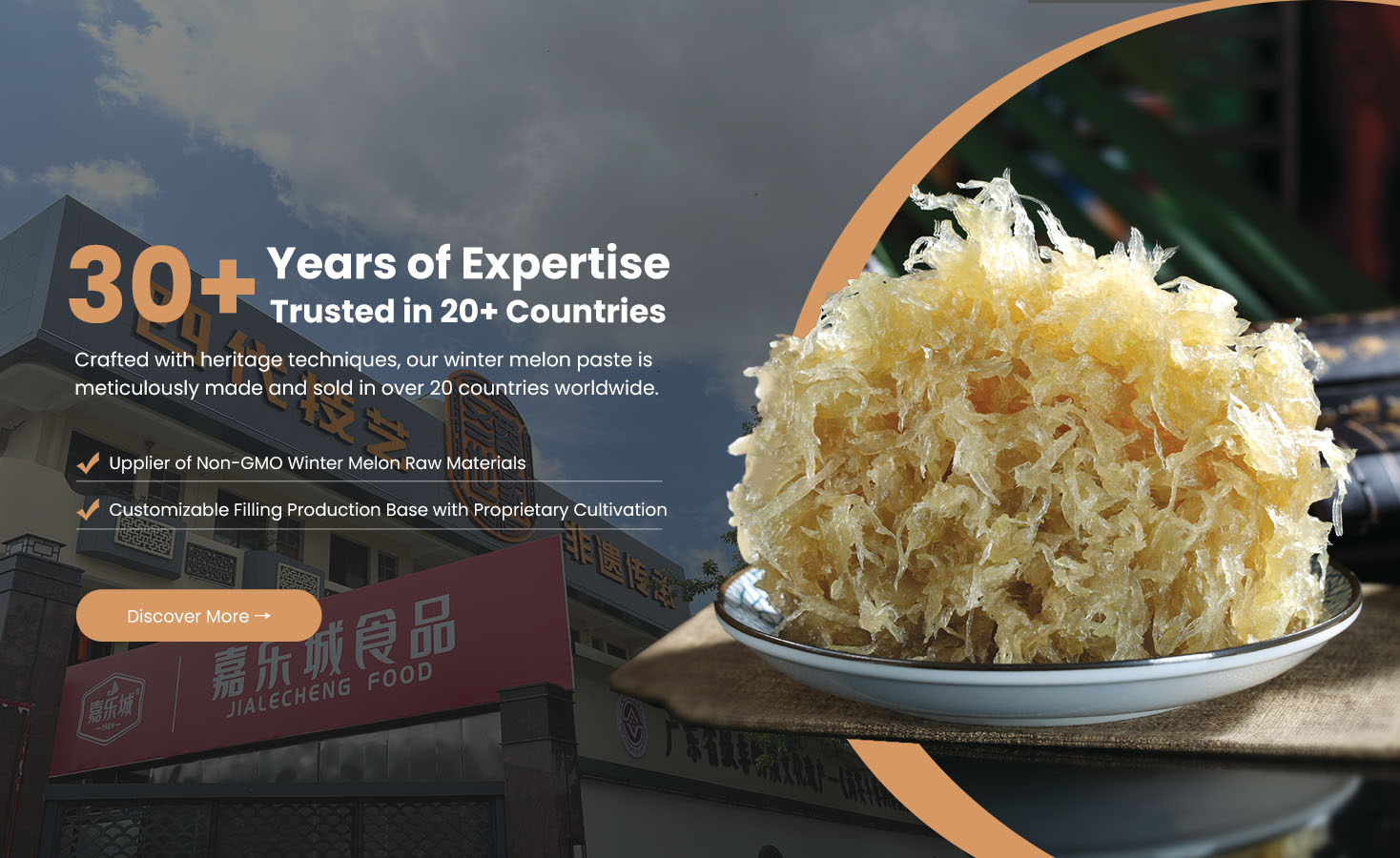How Do You Turn Fresh Winter Melon into Sweet Filling for Baked Goods?
Turning fresh winter melon into a sweet, glossy filling is a traditional technique used widely in Chinese and Southeast Asian bakeries. This process transforms the mild, watery gourd into a smooth, aromatic paste that serves as the base for many pastries — including mooncakes, wife cakes, and sweet buns.
Modern food producers such as Jialecheng Foods in Guangdong, China, have perfected this process using large-scale equipment while preserving the authentic taste and texture of handmade winter melon paste.
Below is a detailed explanation of how to make this unique filling from fresh fruit to finished paste.
1. Ingredients
To make winter melon paste, you only need a few core ingredients — but proportions and technique are key to achieving the right consistency.
| Ingredient | Function |
|---|---|
| Fresh winter melon (peeled and deseeded) | Main ingredient providing natural fiber and mild sweetness |
| White sugar | Adds sweetness and helps preserve the paste |
| Maltose or glucose syrup | Creates shine and elasticity |
| Vegetable oil or shortening | Improves smoothness and baking stability |
| Water | Used during cooking to dissolve sugars |
| Optional flavoring | Coconut, sesame, pineapple, green tea, or bean paste for variation |
2. Step-by-Step Process
Step 1: Preparation and Cleaning
Choose ripe, firm winter melons with white, dense flesh.
Peel the outer green rind and remove the seeds.
Cut the melon flesh into small cubes (about 2–3 cm pieces).
Rinse well to remove excess sap and bitterness.
Purpose: This ensures the filling has a neutral flavor base that easily absorbs sweetness and aromatics later.
Step 2: Blanching
Place the diced melon in boiling water and blanch for 3–5 minutes, then drain.
Why:
Softens the flesh for even cooking.
Reduces the vegetal aroma and bitterness.
Helps the melon absorb sugar more evenly.
Step 3: Simmering with Sugar
Add the blanched melon pieces to a large pot or wok with sugar and water in a 1:0.5 weight ratio (melon:sugar).
Cook on medium heat while stirring constantly.
The melon will release moisture, then begin to soften and turn translucent.
Continue simmering for 45–60 minutes, or until the mixture thickens into a syrupy base.
At this stage, maltose or glucose syrup can be added for gloss and stretchability.
Tip: Industrial producers like Jialecheng Foods use vacuum cookers to maintain texture consistency and prevent caramel overbrowning.
Step 4: Concentrating and Caramelizing
As moisture evaporates, the mixture thickens and becomes glossy. Stir continuously to avoid burning.
Add small amounts of vegetable oil or shortening near the end of cooking.
The paste will gradually pull together into a cohesive, non-sticky mass.
You’ll notice the color shift from pale white to light amber or golden as sugars caramelize slightly.
Goal: Achieve a thick, spreadable texture that holds shape when cooled.
Step 5: Blending and Refining
Once cooked, transfer the mixture to a blender or food processor (industrial producers use fine grinders).
Blend until completely smooth and uniform in texture.
If desired, incorporate flavors such as coconut flakes, sesame paste, or pineapple essence at this stage.
Industrial refinement:
Passed through fine mesh sieves.
Cooked under vacuum pressure to stabilize moisture around 18–22% for long shelf life.
Step 6: Cooling and Storage
Spread the finished paste on trays to cool completely.
Once cool, it can be:
Vacuum-packed for commercial sale.
Stored in airtight containers for up to several months.
Properly made winter melon paste should:
Have a soft but firm consistency.
Not stick to your hands.
Retain a mild, honey-like aroma.
3. Optional Flavor Variations
To adapt the base paste for different baked goods, you can mix in other ingredients after Step 5:
| Flavor | Added Ingredient | Application |
|---|---|---|
| Coconut | Dried coconut flakes | Wife cakes, tropical pastries |
| Pineapple | Pureed pineapple | Fusion desserts |
| Green Tea | Matcha powder | Modern mooncakes |
| Sesame | Roasted sesame paste | Cantonese pastries |
| Lotus Blend | Half lotus paste + half melon paste | Mid-Autumn mooncakes |
4. How It’s Used in Baking
The finished paste can be wrapped directly in dough or mooncake skins.
It can also serve as a base filling, combined with nuts or seeds.
When baked, it remains soft, chewy, and translucent — not dry or grainy.
Baking Stability Tip:
The oil and maltose added during cooking prevent moisture loss and cracking during high-temperature baking.
5. Summary of the Transformation
| Stage | Description | Key Result |
|---|---|---|
| Raw melon | Mild, watery gourd | Blanched for neutral flavor |
| Simmering | Cooked with sugar and maltose | Turns translucent and syrupy |
| Concentrating | Stirred over heat | Thick, golden paste forms |
| Refining | Blended smooth | Uniform texture, ready for filling |
| Cooling | Cooled and stored | Glossy, sweet, bake-stable filling |
6. Conclusion
Turning fresh winter melon into a sweet filling is a precise balance of slow cooking, sugar caramelization, and moisture control. The result is a silky, amber-colored paste that forms the heart of countless traditional Chinese pastries.
Manufacturers like Jialecheng Foods have modernized this craft—using controlled temperature systems, hygienic processing, and vacuum packaging—to produce consistent, export-quality winter melon paste for bakeries worldwide.
Whether made by hand or in a factory, this transformation captures the essence of Asian confectionery: simple ingredients, patient craftsmanship, and natural sweetness.




